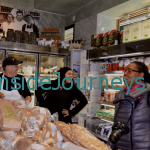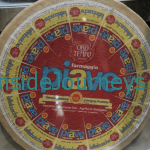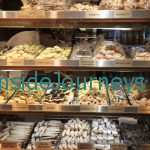I’ve been to Little Italy and Chinatown many times to eat and to shop but never thought of doing a food tour. That is, until this past Saturday when I joined six other women for Ahoy New York’s Chinatown and Little Italy Food Tasting and Cultural Walking Tour.
It was the perfect day to be outside. The temperature that had stayed stuck in the 20s during the early part of the week had moved a full 20 degrees more – almost a heat wave. My friend, Joan, and I met Liz, our guide at the address Ahoy gave us. Liz was all smiles and greeted us as if we were old friends. We chatted for a while and as soon as the others arrived, we were off to Little Italy, the first leg of our tour.

Little Italy, which once spread from Canal Street north to Houston Street, is the area where early immigrants from Italy made their first homes after coming through Ellis Island. At its peak, in the early 1900s, New York’s Italian population numbered about 390,000. Approximately 10,000 lived in Little Italy.
As newcomers in a strange land, they found comfort with others from the regions they’d left, others to who they were bound by dialect, culture and food. So you’d find former residents of Calabria on Mott Street, Silicians on Elizabeth Street and Neapolitans on Mulberry Street.

Life in the US wasn’t easy. They crowded into tenements and cold-water flats, did menial jobs to support their families here and back home. And as their economic situation improved, they spread out to Staten Island, Brooklyn, Queens, the Bronx, New Jersey and Long Island.
Through gentrification, the movement outward of Italians, and the growing population of nearby Chinatown, Little Italy has shrunk. Today, the community takes up only four blocks on Mulberry between Broome and Canal Streets. But what it’s lost in geographic size, it’s more than made up for in heart and soul and good food in over 40 restaurants, cafes and bakeries, that draw thousands of New Yorkers and visitors each year.
In 2010, the National Park Service designated Little Italy and Chinatown a Historic District.
Little Italy Food Tasting and Cultural Walking Tour
Leaving our meeting place on Canal Street, we walked northeast on Mulberry Street, stopping briefly at the historic Most Precious Blood Church, a Roman Catholic Church that has served the community since its founding in 1891.
Continuing on Mulberry, we made our first stop Alleva Dairy at 188 Grand Street. Alleva was established in 1892, by Pina Alleva, the matriarch of the family, who came to the US from Benevento. Alleva, the oldest Italian cheese store in America and is still run by the family.

Alleva does not use artificial flavors. They sell cheese as well as pasta, salami, sausages and imported olive oil, among other items.

At Alleva, we sampled prosciutto and homemade mozzarella. I’ve had mozzarella on pizza but never by itself – its blandness doesn’t make it very appetizing to me. But I was curious to see how the homemade tasted — not that I expected one tasting to change my mind — but I’ve always preferred to start with the best.

Continuing on Grand, our next stop was at Di Palo’s Fine Foods. Another family-run establishment, Di Palo’s has been serving Little Italy since 1910, when Savino Di Palo, a cheese maker, opened his latteria or dairy store.
Now run by the fourth generation, Di Palo’s sells select traditional products that are imported directly from Italy. They carry foods from every region. The staff is friendly and knowledgeable, the counters were designed low enough to give customers the feeling they’re in someone’s kitchen. Di Palo’s believes in educating their customers and has a chef in house and an enoteca (wine shop) next door. (More about this later.)
There were only a few people when we arrived but Liz, our tour guide, said it’s quite different later in the day and on Sundays. (Joan and I saw that when we returned around 5 p.m. to buy cheese. The store was crowded but it took about 20 minutes for us to fill our order.)
At Di Palo’s, we sampled two different cheeses – a piave and a moliterno (pecorino). Piave is made from cow’s milk while the moliterno is made from sheep’s milk with a small percentage of goat’s milk. To keep its moisture and flavor, olive oil is rubbed into the moliterno during the aging process.
Light yellow in color, almost like butter, the piave is hard and has a mild taste. It would be perfect with grapes and other fruits, or on its own. In contrast, the moliterno was sharp and slightly salty. It definitely woke up my tastebuds. I would use it in salads or add it to a cheese platter.
Leaving Di Palo’s, we crossed the street to Grand Appetito for a slice of pizza. As you can imagine, this isn’t any old pizza. Angelo, Grand Appetito’s owner, believes in making pizza the old-fashioned way and uses only homemade mozzarella in his pies.
We made our final stop for cannoli next door at Ferrara Bakery & Café, another family run business. Ferrara has been a fixture in Little Italy since 1892 and is famous for its cannolis and Italian pastries. My cannolo was sweet and creamy. Thankfully, we were on a schedule as I could have easily gotten lost feeding my sweet tooth at Ferrara’s.
After we completed the Little Italy segment of the tour, we crossed Canal for the second half of our tour in Chinatown.
Thanks to Ahoy New York for hosting us on their Chinatown and Little Italy Food Tasting and Cultural Walking Tour, and to Liz, our very knowledgeable, very entertaining and very enthusiastic tour guide.
Liz’s Book Recommendations
[simpleazon-image align=”left” asin=”0547744943″ locale=”us” height=”110″ src=”http://ecx.images-amazon.com/images/I/51iB21JPGzL._SL110_.jpg” width=”73″]Elizabeth Street, Laurie Fabiano
[simpleazon-image align=”left” asin=”0061288519″ locale=”us” height=”110″ src=”http://ecx.images-amazon.com/images/I/51z6LYIXhSL._SL110_.jpg” width=”73″]97 Orchard Street: An Edible History of Five Immigrant Families in One New York Tenement, Jane Ziegelman
How to join the #FoodieTuesday linkup –
- Add the link to your foodie post in the link tool at the bottom of this post
- Leave a comment.
- As a courtesy, please include a link back to this post.
- Tweet, G+, Like, etc., using the hashtag #FoodieTuesday
[inlinkz_linkup id=369020 mode=1 pageSize=300]


















